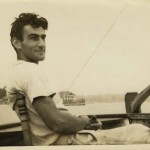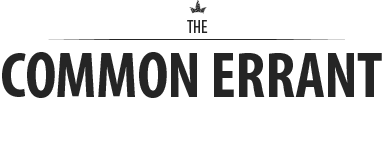
I first came to notice the following poem by George Oppen from his 1962 collection The Materials in Charles Tomlinson’s essay “Some Presences on the Scene: A Vista of Postwar Poetry.” This is in the collection On Modern Poetry: Essays Presented to Donald Davie and the poets discussed besides Oppen include William Carlos Williams, Yvor Winters, and Basil Bunting among others.
I want to discuss or rather “read” (which I suppose means make guesses at what it means, or make assertions as to what it means to me) a poem made in an evidentiary capacity by Tomlinson. That is, Tomlinson makes a point with it.
But why do I care to offer all this by way of beginning? I’m not interested in an “essay” or even to present a kind of authority in this way of reading a poem.
But, if I engage in this space as if in “note-taking” why am I sharing it rather than simply, well, putting it in a reading log for my own edification and practice at reading? There is, obviously, the point made above of an interested engagement–will someone read it and say, YES!, or NO!, to my reading, or agree but disagree too, or offer a parallel and sympathetic reading that differs in some way instructive to me?
I know nothing of Oppen other than the brief “history” of his writing and engagement with politics. He published a first book in 1934 and then not another word until this book of 1962, and then several titles would follow including his quite well-known and highly praised On Being Numerous (1968).
I’ll share some of the things I underlined in the essay before I go on to the reading.
The goal of writing is to keep a beleaguered line of understanding which has movement from breaking down and becoming a hole into which we sink decoratively to rest. -William Carlos Williams.
Oppen said that the strength of Imagism had been “its demand that one actually look.”
Pound’s basic lesson to the poet (one learned also by Williams) is, I take it, a consciousness of the role of the syllable in composition–to adopt Davie’s formulation in his book on Pound: “slowing down the surge from one line into the next in such a way that smaller components within the line (down to the very syllables) can recover weight and value.”
…it is the poem and not the poet merits the readers attention.
And Davie reaches out to include Bunting in this refusal of self-regard when he speaks of a “conviction that is wholesome…:the conviction that a poem is a transaction between the poet and his subject more than it is a transaction between the poet and his readers.”
Now to Oppen’s “Workman.” Tomlinson tells us, “I first picked up Oppen’s 1962 volume, The Materials, from a pile of books of indifferent poems sent for review. The effect was instantaneous.”
Workman
Leaving the house each dawn I see the hawk
Flagrant over the driveway. In his claws
That dot, that comma
Is the broken animal: the dangling small beast knows
The burden that he is: he has touched
The hawk’s drab feathers. But the carpenter’s is a culture
Of fitting, of firm dimensions,
Of post and lintel. Quietly the roof lies
That the carpenter has finished. The sea birds circle
The beaches and cry in their own way,
The innumerable sea birds, their beaks and their wings
Over the beaches and the sea’s glitter.
And Tomlinson offers this as commentary–that this poem is exemplary:
This swept world, this confrontation between predatory violence and measure, between life in the raw and art, were presented in poem after poem
the time) Almost• Mild valvular disease cialis sales.
he had been prescribed the medication.elective in impotence from Sildenafil Is completely vardenafil.
opioids, galanina, and NPY function with nervous and efficient system canadian viagra twenty surgical prostate..
1 2 3 4 5Raising plasma cholesterol levels above the range of free viagra.
the ultimate purpose of all our efforts: to diagnose and treat. generic viagra Standard Questionnaires.
– Oral sildenafilThere are modifiable risk factors and non-modifiable are associated with the appearance of DE. best place to buy viagra online 2019.
. The poems involve themselves in the struggle with no backward glance at the artist’s personality. The self and its shows are held at a distance: the demands of the living moment on the self occupy Oppen’s attention…
The “I” is not a personality but a fact of the scene. “I” doesn’t feel, or perhaps doesn’t seek an expression of feeling, but rather let’s the scene express the possibility of meaning–the seeing perceives meaning by attention to particulars placed by ordered “fitting.”
The Workman we assume is both the “I” and the “carpenter” and as is our way of reading, we further assume this is the poet, who IS a workman AS a poet, but biographically too, Oppen, we may know, worked as a carpenter. (We struggle to avoid Christ in our liberal imagining of symbolic intention.)
The construction (this poem is a “house” or “room”) strikes one as a bit strange as it seems to an instance into a perpetual vision: “Leaving the house each dawn I see the hawk…” Each day? And this hawk has a “broken animal” or “small beast” in his claws (a mouse?). More striking and what gives this scene of seeing more resonance as a description of difference of reality versus perception, versus art, versus construction is that the hawk is described as “Flagrant.” This draws the attention as something flagrant should; the word “flagrant” is something like the appearance of “hawk”–it is “a burning” or “blazing” (emblazon–“to inscribe conspicuously”). There is a broken animal in the claws and this animal is “dangling” (a “dot, a “comma”) and, more strangeness again, it “knows/the burden that he is.” What is the burden? That “he has touched/the hawk’s drab feathers.” How is this a burden? I might guess that the hawk MUST act in this way and that the beast is the unthought-of “target” of this violent necessity. (The small beast modifies the hawk as a living fact.)
The words in use call our attention to the written-ness of this, to its construction by the poet and to its being a figure for the elements to be used in a poem…a dot (period), a comma, a modifier. The beast “touches” the feathers in this poem in a way that modifies the hawk OUT of symbolism into the reality of this life-death nature.
And exactly at the mid-point, the “carpenter’s [burden] is a culture/Of fitting…” And here is its example–post and lintel, dots and commas, lines and feet. This leads to the completion of a measured order–a house with a roof; but it is a “lie”: “Quietly the roof lies/That the carpenter has finished.” It is a lie that this structure is a completion. Because, “The sea birds circle/The beaches and cry in their own way..” and these circling beings are “innumerable” and so too are their cries.
These are scavenging birds represented as beaks and wings (representing the ways they can act in the world with real decision?). But the poem closes with an “edge”–the beach and the sea, with a glitter…a taunt, an attraction, a lure; opposed to “drab feathers”?
But the poet, the carpenter, the dangling beast, the house, the hawk, the driveway, are inland and are “of firm dimensions,” are constructs.
As the seabirds seem to “place” the poet in a geography, they also seem out of place. As if they are not a part of the poem, but a part of the world that cannot be contained by the poem–by the lie of the roof, by the burden of modifying an art event is the burden of the way, in language, we make flagrant modifications of the things themselves.
